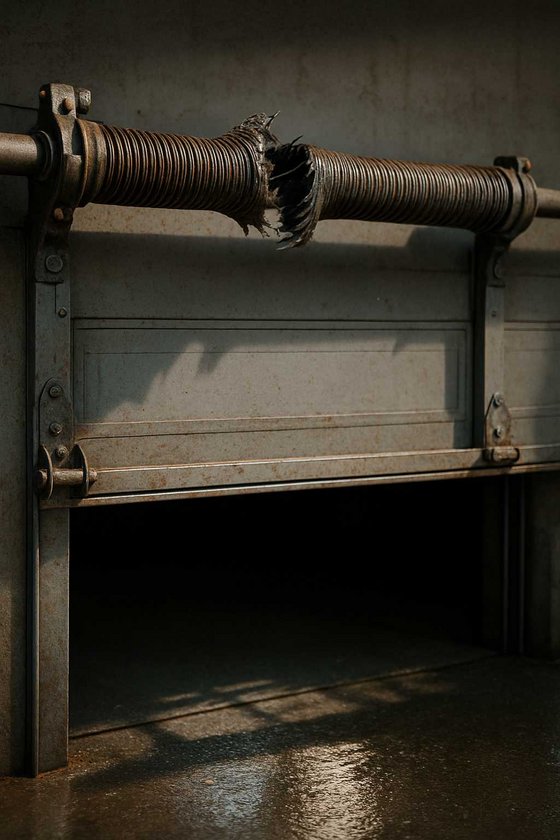
You might think it’s okay to use your garage door even if the spring is broken, but that could be a risky choice. A malfunctioning spring can lead to serious safety hazards and costly repairs. You could end up causing more damage or, worse, injuring someone. So, what are the real dangers of operating a garage door in this condition? Let’s explore the risks and the signs to watch for.
Understanding Garage Door Springs
When you think about your garage door, you mightn't realize just how essential the springs are to its functionality. These springs play an important role in lifting and lowering your door smoothly.
There are two main types: torsion springs and extension springs. Torsion springs are mounted above the door, while extension springs stretch alongside it. Both types store and release energy, helping to counterbalance the door's weight.
When you operate your garage door, the springs bear the load, making it easier for the opener to do its job. If they're functioning well, you won't notice them, but if they fail, you'll quickly realize how critical they are.
Regular maintenance can extend their lifespan, so it’s wise to keep an eye on them. Understanding how these springs work can help you appreciate their importance and encourage you to take better care of your garage door system.
Risks of Operating a Garage Door With a Broken Spring
Operating a garage door with a broken spring can lead to serious safety risks and costly repairs. When the spring fails, the door may suddenly drop or become unbalanced, posing a danger to anyone nearby. You could find yourself in a precarious situation if the door strikes a vehicle, person, or pet, resulting in injury or damage.
Additionally, continuing to use a malfunctioning door can cause further strain on other components, leading to more extensive and expensive repairs.
Moreover, the door’s mechanism is designed to operate under specific tension. When that tension is lost, you risk damaging the opener, tracks, and other parts. It's best to address the issue promptly.
Ignoring a broken spring might seem easier, but the potential hazards and financial implications make it a risky choice. Prioritize safety and get your garage door serviced by a professional as soon as possible.
Signs of a Broken Garage Door Spring
Recognizing the signs of a broken garage door spring is essential for maintaining safety and functionality. One of the first things you might notice is that your garage door isn’t opening or closing properly.
If it hesitates, makes a loud bang, or feels unusually heavy, these could be indicators of a broken spring. You might also see gaps or visible damage in the spring itself, such as breaks or rust.
Listen for strange noises when operating the door; squeaking or grinding sounds can signal a problem. Additionally, if the door only opens partway and then reverses, it’s likely due to spring issues.
Finally, check for unevenness when the door is closed; if one side appears higher than the other, a broken spring could be to blame. Addressing these signs promptly can help prevent more significant issues down the line.
Repairing or Replacing Garage Door Springs
If you’ve noticed any signs of a broken garage door spring, addressing the issue is important for both safety and functionality.
You’ve got two main options: repair or replace the spring. If it’s a minor issue, like a small crack, you might be able to repair it. However, if the spring is severely damaged or worn out, replacing it's usually the best choice.
When tackling this yourself, make sure you’ve got the right tools, including safety glasses and gloves.
Always remember that garage door springs are under high tension, so take precautions to avoid injury. If you’re unsure or uncomfortable, it’s wise to call a professional for garage door repair in Phoenix, AZ. They've the expertise to handle the repair or replacement safely.
Once that spring’s fixed, you’ll notice the difference in your garage door’s operation, making it smooth and safe to use again.
Preventative Maintenance for Garage Door Springs
To guarantee your garage door springs last as long as possible, regular preventative maintenance is essential.
Start by visually inspecting the springs every month for any signs of wear, rust, or damage. If you notice anything unusual, it’s best to address it immediately. Lubricate the springs with a silicone-based spray or a garage door lubricant to keep them functioning smoothly. Make sure to wipe off any excess to avoid attracting dirt.
Additionally, check the balance of your garage door. If it’s off, it can strain the springs and lead to premature failure. Test the door by disconnecting the opener and manually lifting it; it should stay in place.
Finally, schedule a professional inspection at least once a year. They can identify potential issues you might overlook, ensuring your garage door system remains safe and functional for years to come.
Conclusion
To summarize, using a garage door with a broken spring isn't safe and can lead to serious injuries or costly damage. If you notice any signs of a malfunctioning spring, it’s best to address the issue right away. Repairing or replacing the spring not only guarantees your safety but also protects your garage door's longevity. Remember, regular maintenance can prevent future problems, so keep an eye on your springs to avoid unexpected issues down the line.
Brought to you by:
Phoenix Garage Door Repair Near
3631 W Glenn Dr, Phoenix, AZ 85051
(480) 720-8581














